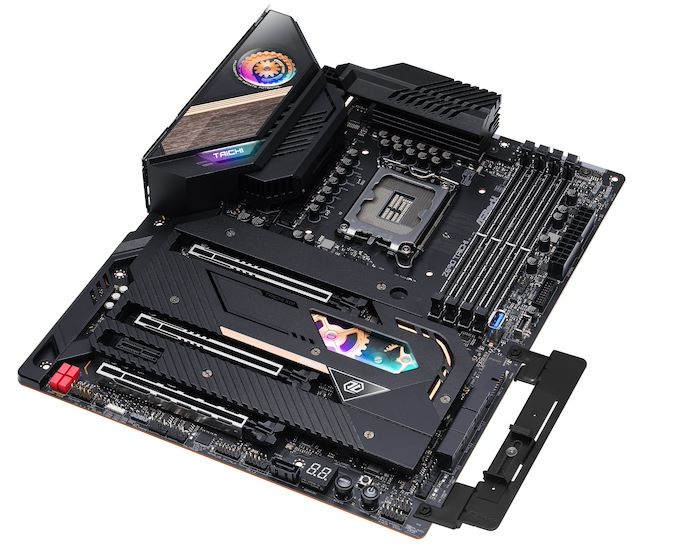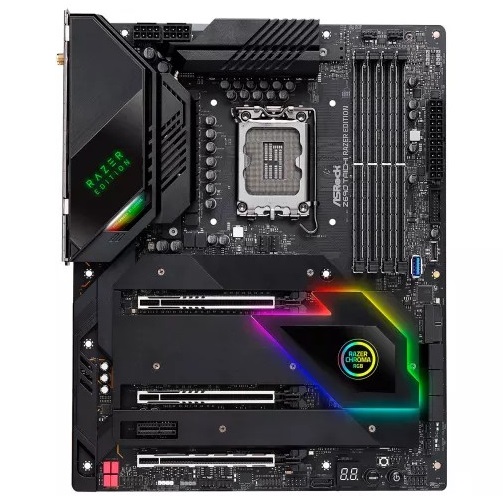The Intel Z690 Motherboard Overview (DDR5): Over 50+ New Models
by Gavin Bonshor on November 9, 2021 9:00 AM ESTASRock Z690 Taichi & Z690 Taichi Razer Edition
Kicking off our Z690 overview in alphabetical order, we'll start with ASRock. ASRock includes its patent-pending ASRock Graphics Card Holder with all of its Z690 models. This is designed to help prevent sagging when used with heavier and long graphics cards.
As it currently stands, the most premium model in ASRock's arsenal for Z690 is from one of its most successful motherboards series, the Taichi. The ASRock Z690 Taichi has a variety of premium features including an advertised 20-phase power delivery with the latest 105 A power stages, as well as a slightly redefined look for 2021. Touching on the design, ASRock includes its mechanical cogwheel effect built into the rear panel cover, which includes RGB LED backlighting, with more RGB built into the cleverly designed cogwheel inspired chipset heatsink.
Looking at the lower portion of the Z690 Taichi, it includes three full-length PCIe slots, including the top two operating at PCIe 5.0 x16 and x8/x8, a third full-length PCIe 4.0 x4 slot, and one PCIe 3.0 x1 slot. Focusing on storage, the ASRock Z690 Taichi includes two PCIe 4.0 x4 M.2 slots, with a third M.2 slot that has support for both PCIe 3.0 x4 and SATA drives. The board also features seven SATA ports in total, with six of these supporting Intel RAID 0, 1, 5, and 10 arrays. Located in the top right-hand corner are four memory slots that can support DDR5-6400, with a combined capacity of up to 128 GB.
The ASRock Z690 Taichi Razer Edition shares the same feature set as the regular Z690 Taichi, but with a Razer-inspired twist. This includes a funky Razer Edition logo on the rear panel cover, with Razer Chroma RGB LED lighting which from the image above, pops really nicely. It drops the cogwheel theme of the Taichi and essentially replaces it with Razer branding.
On the rear panel of the ASRock Z690 Taichi is a pair of Thunderbolt 4 Type-C ports, with two USB 3.2 G2 Type-A, and four USB 3.2 G1 Type-A ports. Onboard audio is handled by a Realtek ALC1220 HD audio codec and ESS Sabre 9218 DAC pairing and consists of five 3.5 mm audio jacks and one S/PDIF optical output. Interestingly, ASRock has put the audio connectors in the middle of the rear panel, as opposed to the end. For networking, ASRock is using a Killer E3100G 2.5 GbE controller, with an additional Intel I219-V Gigabit controller, with a Killer AX1675 Wi-Fi 6E CNVi. Finishing off the rear panel is a single HDMI 2.1 video output and a small BIOS Flashback button.













126 Comments
View All Comments
Flying Aardvark - Wednesday, November 10, 2021 - link
"essentially any board with "Thunderbolt 3" along with USB 3.2 2x2 basically get "USB4" status for free."TB3 can run USB 4.0 devices, while USB 3.2 2x2 should be able to, it would be capped at its 20Gbit/sec and run over the backwards compatibility protocol for USB. USB4 ports can be either 20 or 40Gb.
I wouldn't want just USB 4.0 ports as Apple has, capped at 20Gbps. We'll probably see some of that on the AMD side. The best thing is just to have TB3 or TB4 to be sure you have fullspeed 40Gbps ports.
KarlKastor - Wednesday, November 10, 2021 - link
Just optional. If you have Thunderbolt and 10 Gbit USB, you can call it USB 4. See Apple.OFelix - Tuesday, November 9, 2021 - link
I agree. How come there are so few boards with USB4 or TB4 ?And how come the article doesn't mention them at all before it starts listing specific features of individual boards?
DigitalFreak - Tuesday, November 9, 2021 - link
The only way to get USB4 on a PC was by using Intel's Thunderbolt 4 chipset (or having it built into Tiger Lake). Since Thunderbolt is kind of a niche thing on desktop PCs, motherboard makers aren't interested int spending the money on Intel's TB4 chip except in high end or specialty boards. I would assume there will be some third-party USB4 chips coming soon.OFelix - Wednesday, November 10, 2021 - link
Thanks for your reply.So USB4 was built in to Tiger Lake but its not built in to Alder Lake / Z690????
That would explain somethings but not explain why on earth Intel would do that or AnandTech would not think this major regression worth mentioning!!!
The main reason I want to upgrade from my Sky Lake system (which i purchased to get built in USB3) is to get USB4/TB4.
KarlKastor - Wednesday, November 10, 2021 - link
TB is only integrated in the mobile Dies. The Desktop Die has no TB.Alistair - Tuesday, November 9, 2021 - link
DDR5 is not faster in almost every case, and there are no PCIe 5 devices (unlike when PCIe4 was launched at least you got video cards and storage immediately). Not really an advantage. Prices are too high also. Frankly I like PCIe 3.0 boards when they are under $100 USD.DigitalFreak - Tuesday, November 9, 2021 - link
It's the same thing that happened during the DDR3 to DDR4 transition. The first DDR4 products weren't really any faster than the best DDR3. Eventually DDR4 speeds got faster and left DDR3 behind. Same thing will happen with DDR4 to DDR5.Kevin G - Tuesday, November 9, 2021 - link
PCIe 4.0 support was significantly delayed on the desktop but it arrived in servers in 2017 (IBM Power9). AMD was planning on adopting PCIe 4.0 after Intel on the desktop but Intel's train wreck of their 10 nm manufacturing node derailed the chips what were going to add it (Ice Lake on desktop).I would expect both PCIe 5.0 graphics and storage by the end of 2022 on the desktop, though their benefits will be marginal outside of a few niches. (Single lane PCIe 5.0 chips for USB4/Thunderbolt 4 and 10 Gbit Ethernet vs. using four PCI 3.0 lanes are cost driven examples.)
Samus - Wednesday, November 10, 2021 - link
Kevin G - I agree, I think in a year there will be PCIe 5.0 devices, but the performance advantages, much like initial PCIe 4.0 devices (RTX 30xx, NVMe SSD's, etc) won't be there until 2023-2024, by which time this platform will already be replaced or significantly less expensive.I don't think Intel is looking to drive a lot of sales with this platform. Not many people are buying $3000 desktop PC's at the moment (and when you consider the platform alone is $500, with a $500 CPU on top of it, $3000 is pretty conservative considering most people buying something like this will want a $1000+ GPU, so that's $2000 for three components.)
Put in perspective, the last launch like this that had a lot of tech that you couldn't take advantage of right away was probably X58. PCIe 2.0 at a time no PCIe 2.0 products existed, and 36 lanes no less, left a ton of room to expand a platform that was already stacked to the gills with embedded tech. In fact it would be years before applications were fully optimized for the bandwidth offered by triple channel memory, let alone quad channel memory that Intel introduced on later HEDT platforms.
The difference though is X690 isn't even HEDT.